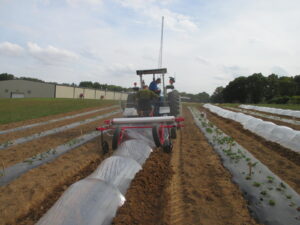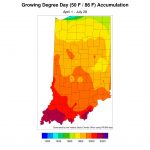Strawberries are primarily grown in matted row system in Indiana, in which bare-root strawberry plants are set in the spring. Runners are established. Fruit is first harvested in the second year and plantings are renovated each year for 2-3 seasons. Growers in the southern part of the state expressed interest in growing strawberries in plasticulture[Read More…]
Found 837 Articles
Due to the COVID crisis, most Purdue Extension meetings will be held virtually. Most Purdue Extension staff are working from home and are available to answer your questions by email, phone or through social media. Our contact information is at the end of the newsletter. September 10-12, 2020 Purdue Extension Master Gardener State Conference Sponsored[Read More…]
This just in from Steven Brown, State Executive Director for USDA’s Farm Service Agency in Indiana CFAP provides direct relief to agricultural producers who faced price declines and additional marketing costs due to COVID-19. In Indiana, we have already approved 15,034 applications and disbursed $164,250.055 as of July 27, 2020. I know many of our farmers[Read More…]
On July 16th, the national Climate Prediction Center released the climate outlooks for August (Figure 1) and the August-September-October (Figure 2) period. Both outlooks are indicating significant probability for above-normal temperatures. Precipitation is likely to be above normal for the southern two-thirds of Indiana in August, but there is little-to-no guidance for the 3-month, August-September-October[Read More…]
FAYETTEVILLE, Ark. — Ouachita blackberry, a 2003 thornless variety from the University of Arkansas System Division of Agriculture, received the Outstanding Fruit Cultivar Award from the Fruit Breeding Professional Interest Group of the American Society of Horticultural Science. The Outstanding Fruit Cultivar Award recognizes noteworthy achievements in fruit breeding and highlights a modern fruit introduction that[Read More…]
Plant nutritional status is important for all phases of plant growth and has a direct effect on vigor, fruitfulness, cold hardiness, and other factors. Tissue analysis is the most reliable means of determining plant nutritional status. Combined with soil testing, tissue analysis can help pinpoint the source of problems and determine what measures may be[Read More…]
Due to the COVID crisis, most Purdue Extension meetings will be held virtually. Most Purdue Extension staff are working from home and are available to answer your questions by email, phone or through social media. Our contact information is at the end of the newsletter. July 30, 2020 Small Farm Education Field Day and Webinar[Read More…]
Grapes are at early to mid-version across most parts of the state, which is about normal timing. There are few disease and insect problems at this stage due to the relatively dry June and early July. However, if we continue to get rainfall as we have experienced lately, expect some berry cracking and potential sour[Read More…]
By now, most harvest is over across the state. As soon as harvest is done, it’s time to begin the renovation process. Matted row strawberry plantings must be renovated each year to establish new crowns for the following year’s crop. For best results, renovation should be started immediately after the harvest is completed to promote[Read More…]
Michigan State University is seeking help to conduct a survey for QoI/FRAC 11 resistant powdery mildew populations around the Great Lakes region. MSU and FRAME are seeking your help to conduct this survey. Please contact Nancy Sharma, a plant pathology graduate student, at sharm115@msu.edu if you are interested in helping us. You will receive a[Read More…]
Purdue University prohibits discrimination against any member of the University community on the basis of race, religion, color, sex, age, national origin or ancestry, genetic information, marital status, parental status, sexual orientation, gender identity and expression, disability, or status as a veteran. This material may be available in alternative formats. 1-888-EXT-INFO Disclaimer: Reference to products in this publication is not intended to be an endorsement to the exclusion of others which may have similar uses. Any person using products listed in this publication assumes full responsibility for their use in accordance with current directions of the manufacturer.


